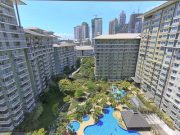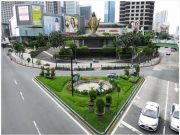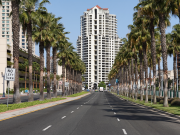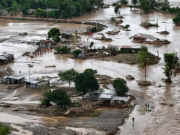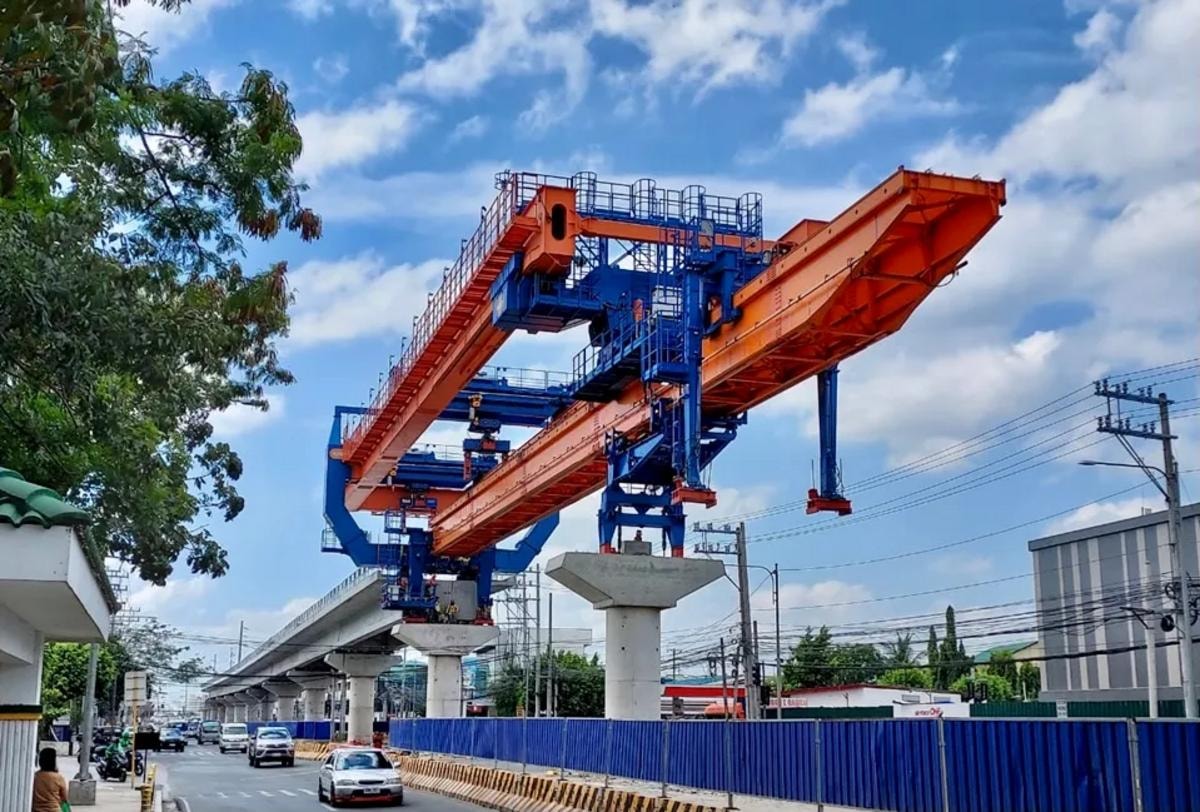
Executive Summary
By Sheila Viesca, Ph.D.
With insights from John Riad, CEO of HousingInteractive
The Philippine real estate market is experiencing a remarkable shift, largely fueled by the government’s ambitious “Build Better More” infrastructure initiative and ongoing improvements that are changing the definition of what makes a location “prime.” It’s no longer just about being close to urban centers; now, prime spots are all about connectivity and accessibility, thanks to new transportation networks like railways, highways, bridges, and airports. Key projects such as the Metro Manila Subway and North-South Commuter Railway are altering buyer preferences, driving up land values, and sparking residential developments and commercial growth in areas once considered outlying. This emphasis on Transit-Oriented Developments (TODs) is not only reshaping urban planning but also creating fresh investment opportunities, while simultaneously boosting local economies through job creation and a surge in housing demand.
As buyer preferences evolve, there’s a rising interest in integrated, sustainable communities that offer amenities like green spaces and dependable digital connectivity. This transformation requires strategic investments and collaborative planning to ensure inclusive and sustainable growth.
This report explores how transportation infrastructure and developers are collaboratively transforming the Philippine real estate landscape. It features actionable insights from HousingInteractive, the country’s top online brokerage, with human development strategies from TalkShop, a leadership and communication training specialist. This infrastructure-driven evolution sets the Philippines on a path for ongoing economic growth and sustained expansion in its real estate sector.
The Power of Connectivity: Access as the New Currency
Mixed-use developments, residential projects, green spaces, and co-living arrangements are gaining traction in the Philippine real estate scene, largely thanks to the growing interest from young professionals. The importance of connectivity and accessibility, bolstered by public transportation and digital infrastructure development, plays a crucial role in these emerging key trends. Major road networks and projects like the North Luzon Expressway are fueling robust growth and development across the country. Government agencies and public-private partnerships are working closely to ensure that this expansion of real estate is both sustainable and inclusive. Additionally, increasing interest from foreign visitors and investors underscores the market’s strong potential for long-term growth and attractive returns.
Having good access is essential in a fast-evolving archipelago like the Philippines. From the sprawling urban expanse of Metro Manila to the distinctive islands of Visayas and Mindanao, new transportation networks and major infrastructure projects are actively shaping the landscape of real estate trends. The Department of Transportation (DOTr) has reported significant progress from 2016 to 2024, including the construction or enhancement of over 6,400 km of roads, the building or upgrading of 1,200 bridges, and the completion of 84 airport and seaport projects.
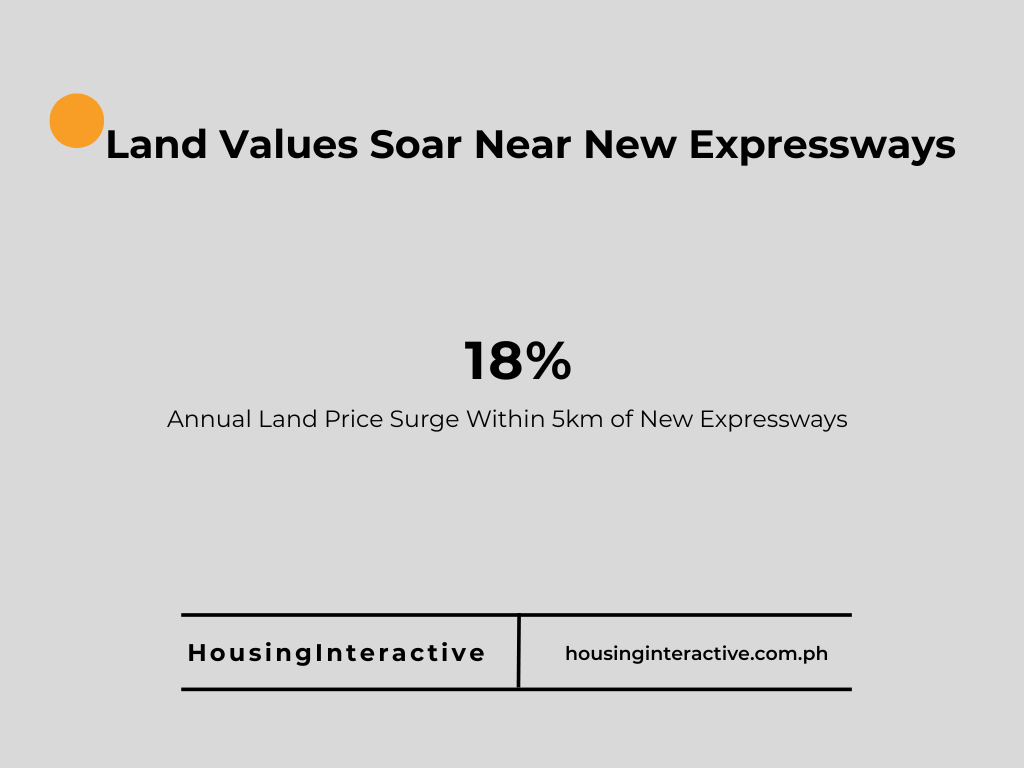
These government efforts have made a real difference in the property market. According to HousingInteractive’s 2025 analytics, real estate demand has driven land prices in areas within a 5 km radius of new expressways to jump by an impressive 18% annually. Listings near future rail stations have seen a whopping 37% increase in inquiries, showing a strong demand in anticipation. Notably, buyer preferences are evolving; today, commute times have become a more critical factor than traditional considerations like city or provincial location.
As John Riad, CEO of HousingInteractive, aptly puts it,
Access is the new currency. We’re seeing demand not just in big cities, but in places people can now reach faster, safer, and more affordably.
Game-Changing Projects: Shaping New Property Hotspots
Improved infrastructure development plays a crucial role in driving economic growth and creating jobs, bringing positive benefits to local communities and the real estate sector. In the Philippines, the economy is reaping the rewards of heightened activity in vital areas like the real estate market and construction, thanks to strategic investments in infrastructure improvements. However, we need to tackle challenges such as traffic congestion and land use conflicts to ensure that property development remains sustainable. To address these issues, collaborative strategies—like green bonds—are being considered to reduce the environmental impact of real estate projects. With ongoing infrastructure expansion and real estate investments, the country is set for continued growth and development.
Several groundbreaking transportation projects are leading this transformation, creating new real estate hotspots and unlocking significant land value:
| North-South Commuter Railway (NSCR): | This ambitious railway system connects Clark in Central Luzon to Calamba in Laguna Province, strategically linking major residential areas with key economic zones. Its development is already shaping growth along its route. |
| Metro Cebu Expressway: | A 74-km road project aimed at greatly enhancing accessibility across Cebu’s vibrant cities and picturesque highlands, promoting integrated growth. |
| Bataan-Cavite Interlink Bridge: | This impressive 32-km structure will establish a direct connection between Central Luzon and the CALABARZON region, paving the way for exciting new development opportunities. |
| Mindanao Railway Phase 1: | Designed to connect Davao, Tagum, and Digos, this project aims to stimulate comprehensive real estate growth and economic activity throughout parts of Mindanao. |
Each of these initiatives is crucial in redefining existing real estate hotspots, revealing previously overlooked land value, and actively promoting the development of office spaces and integrated, self-sustaining townships.
The Rise of Transit-Oriented Development (TOD)
Transit-Oriented Development (TOD) has become a key strategy for governments and real estate developers. This approach focuses on creating real estate seamlessly integrated around major transport hubs, promoting compact, walkable, and interconnected communities. Here are some standout examples of TOD in action:
| Clark Green City: | This expansive urban project is designed to mesh perfectly with current and future transport networks, including airports, major highways, and the NSCR. |
| BGC–Ortigas Bridge: | This vital infrastructure development has significantly boosted property values in areas that were once harder to reach, like Sta. Monica and Kapitolyo, making them much more appealing thanks to improved access to major business districts. |
| Makati Subway: | The upcoming Makati Subway is set to be a major catalyst for luxury residential projects and commercial properties, especially in prestigious neighborhoods like Legaspi and Salcedo Villages, further enhancing their appeal. |
Data from HousingInteractive highlights the growing trend of TOD, showing over 3,000 units aligned with this concept, with a large number still in the pre-selling phase. This indicates strong confidence from both investors and buyers in these well-connected developments.
Socio-Economic Ripple Effects: Infrastructure, Jobs, and Homes
The effects of infrastructure development reach far beyond just property values; they create a ripple effect that significantly impacts the socio-economic landscape. Each major project sets off a chain reaction of job creation, not just in construction and logistics, but also in vital sectors like education, healthcare, and retail. This vibrant cycle leads to:
- In-migration: As new job opportunities arise in these developing areas, workers and their families naturally flock to these growth corridors.
- Housing Demand: This surge in population drives a heightened need for affordable and mid-range housing options in these emerging hubs.
- Ancillary Growth: Economic activity and population increases stimulate the development of essential facilities such as retail centers, schools, and healthcare clinics.

According to the HousingInteractive report, an intriguing trend of a 23% increase in home searches from provincial workers earning less than PHP 80,000 a month, highlighting urban expansion. Many of these individuals are intentionally opting for well-connected locations that promise better commutes and less congestion, steering clear of the traditional, often overcrowded urban centers.
Case Studies: Real-World Property Transformations
The influence of infrastructure projects on property markets comes to life when we look at some real-world examples:
| Tarlac: Central Luzon’s Convergence Point: | Tarlac has quickly become one of the most sought-after property hotspots in Luzon. Its appeal lies in its fantastic accessibility via SCTEX (Subic-Clark-Tarlac Expressway) and TPLEX (Tarlac-Pangasinan-La Union Expressway), along with its proximity to Clark International Airport and its role in the larger Luzon Spine Expressway Network (LSEN). Since 2023, property searches in Capas and Concepcion have skyrocketed by 41%. Major real estate developers like Megaworld and Ayala are launching new township projects, drawing in young professionals from Metro Manila looking for second homes or primary residences in a more connected yet less crowded setting. HousingInteractive predicts that property values in Tarlac will keep rising as it cements its status as Central Luzon’s hub. |
| Tagum (Mindanao Railway): A Rising Star: | The Mindanao Railway Project is poised to transform travel and development by linking Davao, Tagum, and Digos, slashing travel times by up to 60%. Tagum, once a quiet agricultural town, is now emerging as a star in the property market. Since 2022, property values have jumped by 23%, fueled by new townships that feature smart homes and eco-friendly designs. This growth has also attracted Business Process Outsourcing (BPO) companies and other investors, who are setting up regional offices. HousingInteractive has noted a remarkable 38% year-on-year increase in inquiries from Overseas Filipino Workers (OFWs) specifically interested in Tagum properties. |
John Riad aptly notes,
Tagum isn’t just rising—it’s being propelled.
The Evolving Metro Mindset and Digital Connectivity
The way we choose where to live has changed over time. It’s no longer just about how close you are to your job. Nowadays, people are all about lifestyle and convenience, asking themselves questions like:
- “Can I get to work in under an hour, twice a week?”
- “Is there fiber internet and backup power?”
- “Can I raise a family with less traffic and more green space?”
HousingInteractive’s Mobility Index showcases the top spots for relocation that reflect this new “metro mindset”: Lipa, Calamba, and Malolos in Luzon; Consolacion and Talisay in the Visayas; and Tagum and Digos in Mindanao.
But let’s not forget about “The Invisible Highway”: our digital infrastructure. While physical transportation helps us get around, having strong digital connectivity is key for a good quality of life and ongoing growth. People relocating to new areas now expect fast and reliable internet, seamless access to online services such as banking, healthcare, and government platforms, along with dependable support for remote work. The Department of Information and Communications Technology (DICT) has launched the “Broadband ng Masa” initiative, aiming for universal digital access by 2028. Understanding its significance, HousingInteractive now includes detailed broadband information in its listings, helping buyers find livable areas.
As Riad concludes,
Infrastructure lets you arrive. Digital lets you stay.
Navigating Challenges: Risks, Regulation, and Sustainable Growth
While developing infrastructure can bring significant advantages, it also comes with its fair share of risks if not handled carefully. Here are a few to consider:
- Overdevelopment: When construction around transport hubs spirals out of control, it can lead to traffic jams and put a strain on local resources.
- Ecological Degradation: Large projects can harm the environment if they aren’t planned with sustainability in mind.
- Speculative Land Pricing: When property values skyrocket too quickly, it can lead to speculative buying, making homes unaffordable for the local community.
To address these challenges, Comprehensive Land Use Plans (CLUPs) and zoning ordinances are in place for all major infrastructure corridors. HousingInteractive is dedicated to responsible development by partnering exclusively with compliant developers and local government units (LGUs). Additionally, modern housing developments and infrastructure projects are increasingly embracing eco-friendly planning features, such as rainwater harvesting systems, green belts, biodiversity corridors, and infrastructure for pedestrians and cyclists, along with energy-efficient stations and terminals. Developers who adhere to these sustainability practices, like those seen in New Clark City and the Davao Bypass Road, enjoy quicker project approvals and greater investor confidence.
HousingInteractive’s Tools for Informed Decisions
To help buyers and investors navigate this ever-changing market, HousingInteractive offers a range of essential tools and services:
- Transport Tracker: A handy filter that lets users find listings based on how close they are to expressways, railways, or airports.
- ROI Forecasts: In-depth projections on return on investment specifically tailored for Transit-Oriented Development (TOD) properties.
- Community Readiness Assessments: Thorough evaluations that shed light on important factors like access to schools, healthcare facilities, and internet speed, ensuring buyers select truly viable and sustainable communities.
These tools are crafted to ensure that investments are not just smart and profitable but also sustainable and ready for the future, aligning with the long-term vision for development in the Philippines.
The Human Dimension: Adapting to Geographic Transition
While new infrastructure projects open up physical access, the real success of these developments depends on how well individuals and communities adapt to these geographic changes. TalkShop plays a vital role in supporting this human aspect of development by:
- Coaching Relocated Professionals: Offering essential communication and leadership coaching to help professionals flourish in new settings.
- Stakeholder Communication Training: Equipping Local Government Units (LGUs) and developers with effective strategies to engage stakeholders during the development and transition phases.
- Preparing for New Lifestyles: Helping individuals and families get ready for hybrid work models and adjust to life in emerging hubs.
- Empowering Local Entrepreneurs: Training local businesses to meet the changing needs of incoming populations and new economic activities.
- Fostering Community Integration: Training local businesses to meet the changing needs of incoming populations and new economic activities.
As Sheila Viesca, CEO of TalkShop, emphasizes, “Infrastructure builds access. People need readiness to use it. Growth must be community-led.”
TalkShop’s programs in areas like San Pedro, Tagum, and Capas demonstrate how “soft skills” in human development significantly multiply the value of “hard infrastructure.”
Conclusion: From Access to Empowerment – Building Possibilities
The ongoing infrastructure projects boom is truly transforming the physical landscape of the Philippines. Yet, its most significant and enduring impact will go beyond concrete and steel. It will be seen in empowered communities: families thriving beyond the crowded confines of Metro Manila, professionals taking charge in revitalized provinces, and local economies flourishing thanks to improved access and inclusion.
HousingInteractive, with its in-depth market insights, is diligently monitoring the changes in the property landscape. At the same time, TalkShop equips individuals to navigate these new opportunities, ensuring they have the skills and readiness to adapt and thrive. Together, these two organizations are doing more than just facilitating property transactions; they are actively shaping a future filled with expanded possibilities in strategic locations throughout the Philippine archipelago.



